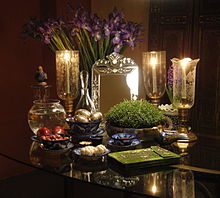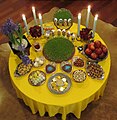Haft-sin

Haft-sin (Persian: هفتسین; "seven [items beginning with the letter] seen (S)"), also spelled as Haft-seen, is an arrangement of seven symbolic items whose names start with the letter seen in the Persian alphabet.[1][2] It is traditionally displayed at Nowruz, the Iranian New Year's day, which is celebrated on the day of the vernal equinox, marking the beginning of spring on the Northern Hemisphere.
Items
The following are the primary items of Haft-sin, whose Persian names begin with the letter sin in the Persian alphabet.[1][2]
- Sabze (سبزه) – wheat, barley, mung bean, or lentil sprouts grown in a dish.
- Samanu (سمنو) – sweet pudding made from wheat germ.
- Senjed (سنجد) – Persian fruit .
- Serke (سرکه) – vinegar.
- Sib (سیب) – apple.
- Sir (سیر) – garlic.
- Somāq (سماق) – sumac.
Other symbolic items that are typically used to accompany Haft-sin include a mirror, candles, painted eggs, a bowl of water, goldfish, coins, hyacinth, and traditional confectioneries. A "book of wisdom" is also commonly included, which might be the Quran, the Bible, the Avesta, the Šāhnāme of Ferdowsi, or the divān of Hafez.[1]
Gallery
-
Wheatgrass, one of the items of Haft-sin.
-
An egg painting festival in Tehran.
-
A bowl of samanu, one of the items of Haft-sin.
-
Goldfish, one of the items of Haft-sin.
-
A Haft-sin table at the White House.
-
A Haft-sin table at a hotel in Tehran.
-
A Haft-sin table at Sharif University of Technology.
-
A Haft-sin table.
-
A Haft-sin table.
-
A Haft-sin table.
-
A Haft-sin table.
-
A Haft-sin table.
-
A Haft-sin table.
-
A Haft-sin table.
-
A Haft-sin table.
See also
- Passover Seder plate, a similar display for the Jewish holiday of Passover.
References
External links
- Shahbazi, A. Shapur (March 1, 2012). "HAFT SIN". Encyclopaedia Iranica. Vol. XI. pp. 524–526.














